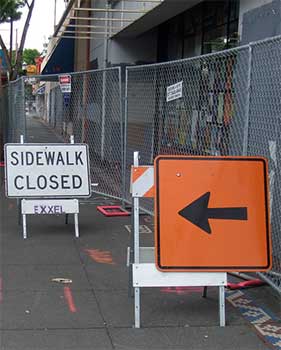 Much like most major cities, in Seattle there are currently a number of construction projects underway. Old buildings have been demolished to give way to new apartment complexes, office buildings, and retail establishments. It’s exciting to see different neighborhoods getting more built up, but there’s been an irksome downside to all the construction (well, aside from the noise): sidewalk closures.
Much like most major cities, in Seattle there are currently a number of construction projects underway. Old buildings have been demolished to give way to new apartment complexes, office buildings, and retail establishments. It’s exciting to see different neighborhoods getting more built up, but there’s been an irksome downside to all the construction (well, aside from the noise): sidewalk closures.
Construction companies typically have the reputation of being able to get away with directing traffic or closing streets and sidewalks so they can navigate their large trucks and equipment to and from the construction site. However, we’re starting to hit a tipping point where the sidewalk closures are becoming a problem. The Seattle publication The Stranger recently wrote about the increase in people walking on the streets in traffic due to the numerous sidewalk closures near these construction projects. The pedestrians are technically supposed to cross the street and use the available sidewalk there, but hardly anyone is doing that. Instead, more and more Seattleites are strolling down the side of a busy street, which poses safety concerns as they’re at a higher risk of getting clipped by a car.
The Stranger cites three construction sites in the Capitol Hill neighborhood that have closed down sidewalks for the benefit of developers while massively inconveniencing pedestrians. I live in this neighborhood and have definitely noticed the increase in sidewalk closures. It’s not like these construction sites are tearing up the sidewalks—they’re just blocking them off for no obvious reason.
To quote The Stranger:
“Is it too much to expect that when construction is permitted in a pedestrian overlay—parts of the city where the zoning explicitly says development must accommodate pedestrians—developers be required to provide a substitute walking lane, a protected barrier? This is typical in East Coast cities, and it seems a reasonable expectation here, too.”
You may roll your eyes and blame the pedestrians here for not going out of their way a little bit to an open sidewalk, but even city hall staffers contacted by The Stranger have admitted to jaywalking around construction sites because of the closures. It’s not a case of “ooh, those crazy youngsters are running through the streets”–people of various ages and demographics are irked, and it’s become a big enough problem that warrants a discussion. Trying to get a number of pedestrians to cross the street and use the other sidewalk is an option, but so is talking to the construction companies and trying to have them be more mindful of the situation.
The Stranger noted they received no pledge from city officials to change the rules and get construction companies to accommodate pedestrians. However, I have noticed at one site in Capitol Hill the sidewalk has been opened back up and there’s now a construction scaffolding framing the walkway. It seems that particular company got the memo to be a bit more thoughtful towards pedestrians. I hope others follow suit—Seattle doesn’t have the greatest public transportation system, so there are a lot of folks who walk to commute from Point A to Point B. Constantly closing sidewalks and inconveniencing these folks could lead to accidents or an increase in the number of cars on the road as pedestrians throw their hands in the air and say, “Screw it, I’ll just hop in my car instead.”
Author Bio
Rebecca Kelley is the Editor-in-Chief at Reputation Management, a resource dedicated to helping individuals and businesses manage their online reputation.

